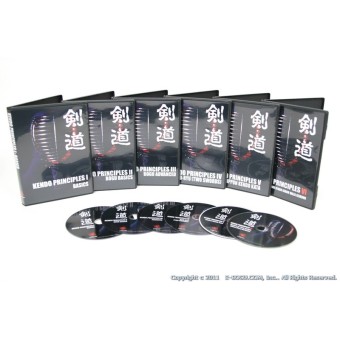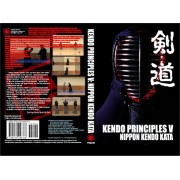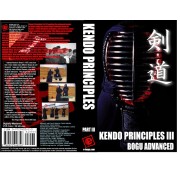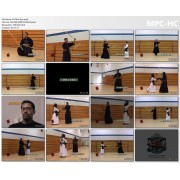KENDO PRINCIPLES I - BASICS
KENDO PRINCIPLES II - BOGU BASICS
KENDO PRINCIPLES III - ADVANCED
KENDO PRINCIPLES IV - NITO-RYU [Two Swords]
KENDO PRINCIPLES V - Nippon Kendo Kata
KENDO PRINCIPLES VI - Bokuto Ni Yoru Kendo Kihon Waza Keiko
Kendo Principles Part I explains the basic movements of Kendo, such as Kamae, Furikaburi, and Suburi. This video can be a guide for Kenshis starting Kendo for self trainning. Dojo Instructors can also take full use of this video as an additional instruction material for their students.
This video is all narrated in English, for easy understanding, and the camera is taken from various angles.
Main topics discussed in this video are the following:
Basic Feet Movements (Ayumi Ashi, Okuri Ashi, Fumikomi)
Basic Positions (Seigan-no-Kamae, Yasume, Sonkyo)
Basic Shinai Movements (Furikaburi, San-Kyodo Men-Uchi, San-Kyodo Kote-Uchi, San-Kyodo Do-Uchi, San-Kyodo Tsuki-Uchi, Zenshin Koutai Men-Uchi, Zenshin Koutai Sayu-Men-Uchi, Jougue-Buri, Renzoku Sayu-Men-Uchi, Kote-Men, Kote-Do, Kote-Men-Do, Hayasuburi)
"I started Kendo in Brazil in 1975, and since then I have visited many different Dojos all over the world. I was very fortunate to have been taught by many different Senseis, who were all great instructors. They taught me not only Kendo techniques, but also the fundamentals of human character. I would like to thank all my Senseis and fellow Kenshis, who had the patience to practice Kendo with me.
Many people asked me if there is a good instructional Kendo Video in languages other than Japanese, and I was not successful finding one. This is the reason I decided to develop one myself, with the hope that it will help many people interested in Kendo outside of Japan.
This Video is based on what I have learned and developed during the 27 years of my Kendo career. My Kendo knowledge is not any close to perfect, however I have tried my best to introduce everything I know, and what I have been taught.
I am open to any comments or suggestions, in order to improve the quality in the next edition of this video series."
This is the Part I of the video series that Taro Ariga is making with Koby Shimada. More advanced techniques, drills, class teaching techniques, tournament rules to come in the near future.
Kendo Principles Part II explains the basic movements of Kendo using the actual Bogu (Protector Armor for Kendo). It also illustrates examples, and incorrect moves which students tend to make. This video can be a useful self-training guide for Kenshis who were recently allowed to wear Bogu. Dojo Instructors can also take full use of this video as an additional instruction material for their students. This video is all narrated in English, for easy understanding and the camera is taken from various angles. Many slow motion shots were taken to illustrate good and bad examples from different angles.
Topics shown in this video are the following:
Men Uchi (Large/Small Movement)
Kote Uchi (Large/Small Movement)
Do Uchi (Large/Small Movement)
Tsuki (Morote Tsuki/Katate Tsuki)
Various combination of the above
Kirikaeshi / Kakarigeiko
Kendo Principles Part III explains advanced movements of Kendo using the Bogu (Protector Armor for Kendo). It also illustrates examples, and incorrect moves which students tend to make. This video can be a useful self-training guide for Kenshis who are experienced in Kendo, in order to improve their techniques and have an in-depth understanding of the advanced techniques. Dojo Instructors can also take full use of this video as an additional instruction material for their students. This video is all narrated in English, for easy understanding and the camera is taken from various angles. Many slow motion shots were taken to illustrate good and bad examples from different angles.
Topics shown in this video are the following:
SHIKAKE WAZA: Omote Kara Men, Ura Kara Men, Ura Kara Kote, Tobikomi Do, Kote Men (Omote), Kote Men (Ura), Tsuki Men, Maki Waza
NUKI-WAZA: Kote Nuki Men
SURIAGE WAZA: Kote Suriage Men (Omote), Kote Suriage Men (Ura), Kote Suriage Kote, Men Suriage Men (Omote), Men Suriage Men (Ura), Men Suriage Kote
KAESHI WAZA: Men Kaeshi Do, Men Kaeshi Gyaku Do, Kote Kaeshi Men
DEBANA WAZA: De-Kote, Degashira Men, Nuki Do, Nuki Gyaku Do, Ai Kote Men
TSUBAZERIAI: Men From Tsubazeri, Kote from Tubazeri, Do from Tubazeri, Gyaku Do from Tsubazeri
Kendo Principles Part IV explains the major techniques of Kendo using two Swords (Nito-Ryu). Miyamoto Musashi, the most famous Samurai in the Japanese history, has developed the Nito-Ryu technique during a combat. This video illustrates correct examples, and incorrect moves which are common to new students. It can also be a useful self-training guide for Kenshis who wants to learn Nito-ryu and have an in-depth understanding of the advanced techniques.
Dojo Instructors can also take full use of this video as an additional instructional material for their students. This video is all narrated in English, for easy understanding and the camera is taken from various angles. Many slow motion shots is taken to illustrate good and bad examples from different angles.
All techniques and moves are explained by Matthew Raymond (Black Belt 5th Dan), one of the most famous Nito-Ryu Kenshis in the world. He has learned his Nito-Ryu techniques during his long training in Osaka, Japan. Matthew has won many big titles and he is currently member of the Canadian national team participating in four World Kendo Championships, placing 3rd place in 1994 and 2000.
BASIC TECHNIQUES: [Sonkyo, Seiza, Kamae (Jodan - Daito, Jodan - Shoto), Distance, Tsubazeriai, Okuri Ashi, Datotsu (Men-Uchi, Kote-Uchi, Do-Uchi, Tsuki-Uchi)]
ADVANCED TECHNIQUES: [Combinations (Kote-Men, Kote-Do), Debana Waza (Debana Men, Debana Kote, Debana Do), Hiki Men, Hiki Kote, Hiki Do, Kakarigeiko, Kirikaeshi, Zanshin]
Kendo Principles V explains the Nippon Kendo Kata in details. It is a perfect source to learn the correct Kata for daily practices or last minute preparation for Dan promotion examinations. This DVD illustrates correct examples, and incorrect moves which are common to new students.
This DVD can also be a useful source for self training guide for Kenshis who want to learn the proper Nippon Kendo Kata in depth. Dojo Instructors can also take full use of this DVD as an additional instructional material for their students. Kendo Principles V can be played in English and Korean, for easy understanding and the camera is taken from various angles.
Many slow motion shots are taken to illustrate correct and incorrect examples from different angles. In the first section of the presentation, the DVD demonstrates the entire ten Katas (seven with the Tachi and three with Kodachi). Then in the second section, it goes through each Kata in details, showing the proper way, and pointing out the common mistakes.
This DVD explains the following in details:
- Nippon Kendo Kata fundamentals
- Benefits of learning the Kendo Kata - Riai & Giho (Meaning and Techniques)
- Kamae (Basic Position) - Reiho (Courtesies)
- Enter the Dojo
- Seven Tachi movements
- Three Kodachi movements
- Exit the Dojo
Kendo Principles VI explains the “Bokuto ni Yoru Kendo Kihon Waza Keikoho” (“Basic
Kendo Techniques Training Method with the use of Bokuto”) in details. It is a perfect
source to learn this Training Method correctly, for daily practices or last minute
preparation for Dan promotion examinations. This DVD illustrates correct examples,
and incorrect moves which are common to new students.
This DVD can also be a useful source for self training guide for Kenshis who want to learn the proper “Bokuto ni Yoru
Kendo Kihon Waza Keikoho” in depth. Dojo Instructors can also take full use of this DVD as an additional instructional
material for their students. In various part of the DVD, we explain the teaching method, and Key points of each moves.
Kendo Principles VI is all narrated in English, for easy understanding and the camera is taken from various angles.
Slow motion shots are also taken to illustrate correct and incorrect examples from different angles.
In the first section of the presentation, the DVD demonstrates the entire nine moves continuously.
Then in the second section, it goes through each movements in details, showing the proper way, and pointing out the
common mistakes.
This DVD explains the following in details:
- Bokuto ni Yoru Kendo Kihonwaza Keikoho fundamentals
- The purpose of learning the Bokuto ni Yoru Kendo Kihonwaza Keikoho
- Awareness during instruction
- Kamae, Reiho, Metsuke, Maai, Datotsu, Ashisabaki, Kakegoe, Zanshin
- Enter/Exit the Dojo
- Nine movements (Kihon 1 to 9)
- Improvement Tips

Instant download only
Format file 6x MP4 540p
duration 5 hours 52 minutes
Release December 2005
Kendo Principles 6 DVD set by Taro Ariga
- Product Code: iai109
- Availability: In Stock
-
Rp.200,000




